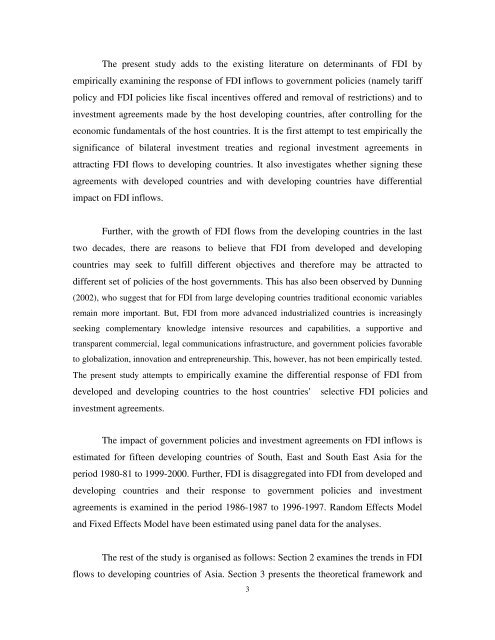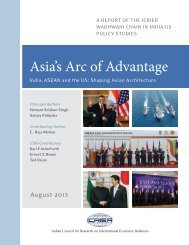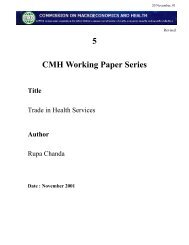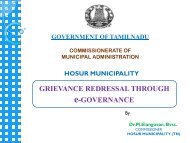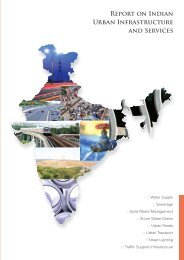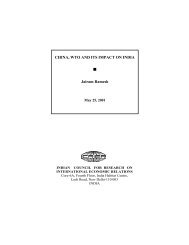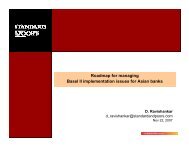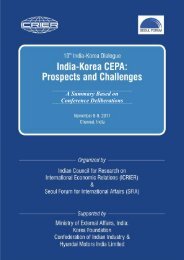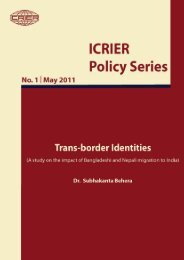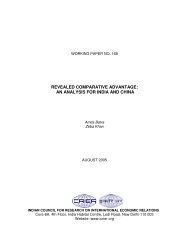impact of government policies and investment agreements on fdi ...
impact of government policies and investment agreements on fdi ...
impact of government policies and investment agreements on fdi ...
You also want an ePaper? Increase the reach of your titles
YUMPU automatically turns print PDFs into web optimized ePapers that Google loves.
The present study adds to the existing literature <strong>on</strong> determinants <str<strong>on</strong>g>of</str<strong>on</strong>g> FDI by<br />
empirically examining the resp<strong>on</strong>se <str<strong>on</strong>g>of</str<strong>on</strong>g> FDI inflows to <str<strong>on</strong>g>government</str<strong>on</strong>g> <str<strong>on</strong>g>policies</str<strong>on</strong>g> (namely tariff<br />
policy <str<strong>on</strong>g>and</str<strong>on</strong>g> FDI <str<strong>on</strong>g>policies</str<strong>on</strong>g> like fiscal incentives <str<strong>on</strong>g>of</str<strong>on</strong>g>fered <str<strong>on</strong>g>and</str<strong>on</strong>g> removal <str<strong>on</strong>g>of</str<strong>on</strong>g> restricti<strong>on</strong>s) <str<strong>on</strong>g>and</str<strong>on</strong>g> to<br />
<str<strong>on</strong>g>investment</str<strong>on</strong>g> <str<strong>on</strong>g>agreements</str<strong>on</strong>g> made by the host developing countries, after c<strong>on</strong>trolling for the<br />
ec<strong>on</strong>omic fundamentals <str<strong>on</strong>g>of</str<strong>on</strong>g> the host countries. It is the first attempt to test empirically the<br />
significance <str<strong>on</strong>g>of</str<strong>on</strong>g> bilateral <str<strong>on</strong>g>investment</str<strong>on</strong>g> treaties <str<strong>on</strong>g>and</str<strong>on</strong>g> regi<strong>on</strong>al <str<strong>on</strong>g>investment</str<strong>on</strong>g> <str<strong>on</strong>g>agreements</str<strong>on</strong>g> in<br />
attracting FDI flows to developing countries. It also investigates whether signing these<br />
<str<strong>on</strong>g>agreements</str<strong>on</strong>g> with developed countries <str<strong>on</strong>g>and</str<strong>on</strong>g> with developing countries have differential<br />
<str<strong>on</strong>g>impact</str<strong>on</strong>g> <strong>on</strong> FDI inflows.<br />
Further, with the growth <str<strong>on</strong>g>of</str<strong>on</strong>g> FDI flows from the developing countries in the last<br />
two decades, there are reas<strong>on</strong>s to believe that FDI from developed <str<strong>on</strong>g>and</str<strong>on</strong>g> developing<br />
countries may seek to fulfill different objectives <str<strong>on</strong>g>and</str<strong>on</strong>g> therefore may be attracted to<br />
different set <str<strong>on</strong>g>of</str<strong>on</strong>g> <str<strong>on</strong>g>policies</str<strong>on</strong>g> <str<strong>on</strong>g>of</str<strong>on</strong>g> the host <str<strong>on</strong>g>government</str<strong>on</strong>g>s. This has also been observed by Dunning<br />
(2002), who suggest that for FDI from large developing countries traditi<strong>on</strong>al ec<strong>on</strong>omic variables<br />
remain more important. But, FDI from more advanced industrialized countries is increasingly<br />
seeking complementary knowledge intensive resources <str<strong>on</strong>g>and</str<strong>on</strong>g> capabilities, a supportive <str<strong>on</strong>g>and</str<strong>on</strong>g><br />
transparent commercial, legal communicati<strong>on</strong>s infrastructure, <str<strong>on</strong>g>and</str<strong>on</strong>g> <str<strong>on</strong>g>government</str<strong>on</strong>g> <str<strong>on</strong>g>policies</str<strong>on</strong>g> favorable<br />
to globalizati<strong>on</strong>, innovati<strong>on</strong> <str<strong>on</strong>g>and</str<strong>on</strong>g> entrepreneurship. This, however, has not been empirically tested.<br />
The present study attempts to empirically examine the differential resp<strong>on</strong>se <str<strong>on</strong>g>of</str<strong>on</strong>g> FDI from<br />
developed <str<strong>on</strong>g>and</str<strong>on</strong>g> developing countries to the host countries' selective FDI <str<strong>on</strong>g>policies</str<strong>on</strong>g> <str<strong>on</strong>g>and</str<strong>on</strong>g><br />
<str<strong>on</strong>g>investment</str<strong>on</strong>g> <str<strong>on</strong>g>agreements</str<strong>on</strong>g>.<br />
The <str<strong>on</strong>g>impact</str<strong>on</strong>g> <str<strong>on</strong>g>of</str<strong>on</strong>g> <str<strong>on</strong>g>government</str<strong>on</strong>g> <str<strong>on</strong>g>policies</str<strong>on</strong>g> <str<strong>on</strong>g>and</str<strong>on</strong>g> <str<strong>on</strong>g>investment</str<strong>on</strong>g> <str<strong>on</strong>g>agreements</str<strong>on</strong>g> <strong>on</strong> FDI inflows is<br />
estimated for fifteen developing countries <str<strong>on</strong>g>of</str<strong>on</strong>g> South, East <str<strong>on</strong>g>and</str<strong>on</strong>g> South East Asia for the<br />
period 1980-81 to 1999-2000. Further, FDI is disaggregated into FDI from developed <str<strong>on</strong>g>and</str<strong>on</strong>g><br />
developing countries <str<strong>on</strong>g>and</str<strong>on</strong>g> their resp<strong>on</strong>se to <str<strong>on</strong>g>government</str<strong>on</strong>g> <str<strong>on</strong>g>policies</str<strong>on</strong>g> <str<strong>on</strong>g>and</str<strong>on</strong>g> <str<strong>on</strong>g>investment</str<strong>on</strong>g><br />
<str<strong>on</strong>g>agreements</str<strong>on</strong>g> is examined in the period 1986-1987 to 1996-1997. R<str<strong>on</strong>g>and</str<strong>on</strong>g>om Effects Model<br />
<str<strong>on</strong>g>and</str<strong>on</strong>g> Fixed Effects Model have been estimated using panel data for the analyses.<br />
The rest <str<strong>on</strong>g>of</str<strong>on</strong>g> the study is organised as follows: Secti<strong>on</strong> 2 examines the trends in FDI<br />
flows to developing countries <str<strong>on</strong>g>of</str<strong>on</strong>g> Asia. Secti<strong>on</strong> 3 presents the theoretical framework <str<strong>on</strong>g>and</str<strong>on</strong>g><br />
3


